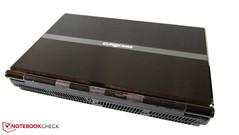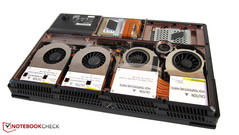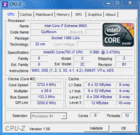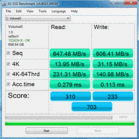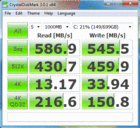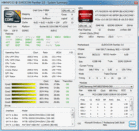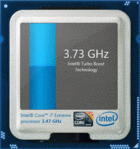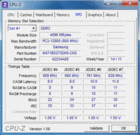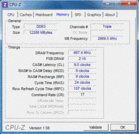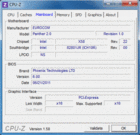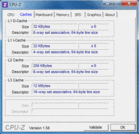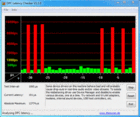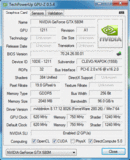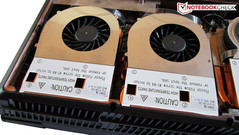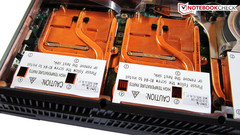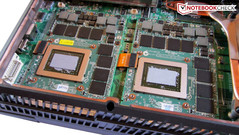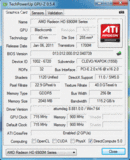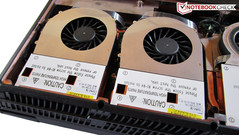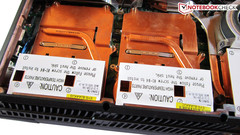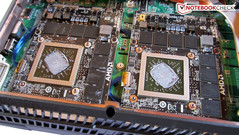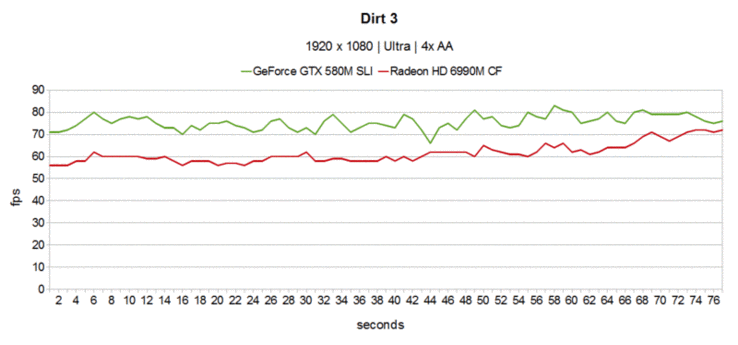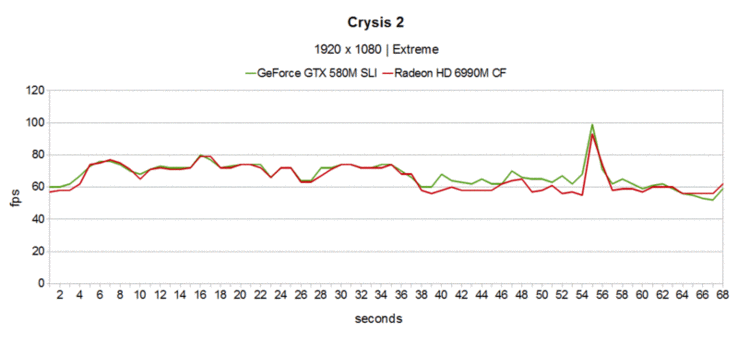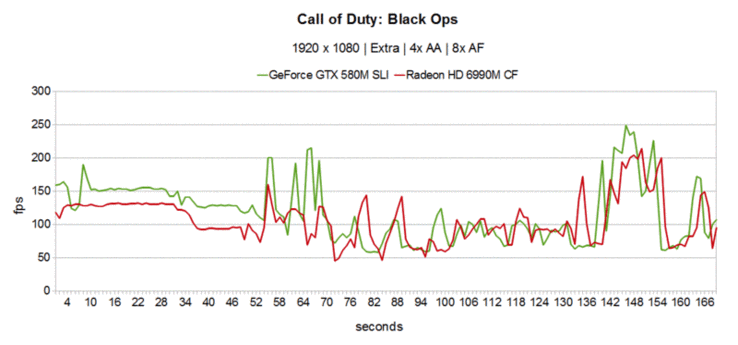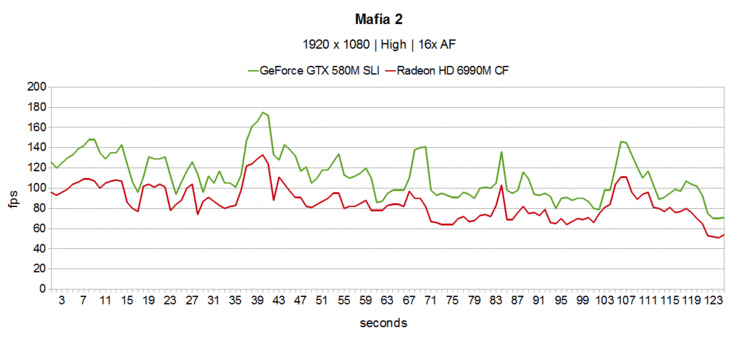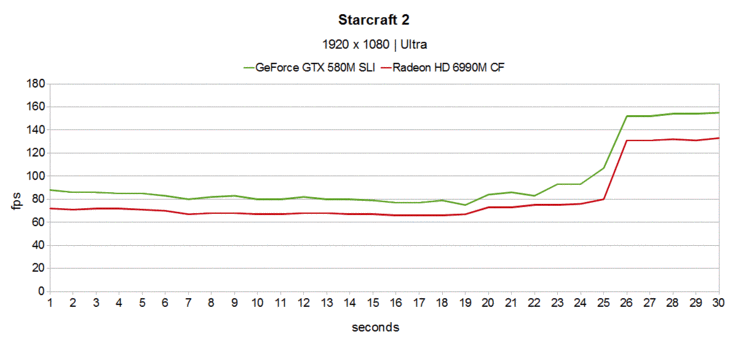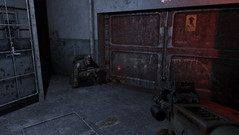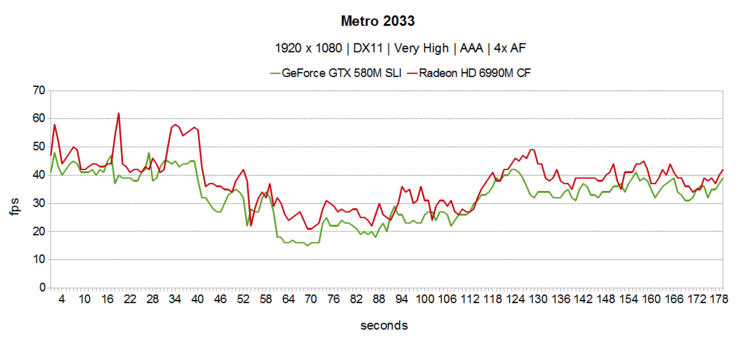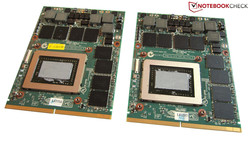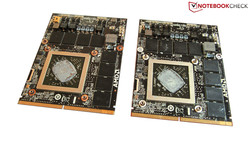Review GeForce GTX 580M SLI vs. Radeon HD 6990M CF
Notebooks with dual graphic cards are intended for enthusiasts and high-end gamers. These devices are not suited for the general public, as, in comparison to desktop PCs, the dual-graphic systems of laptops are expensive, consume a lot of power. Furthermore, the laptop is heavy and creates a lot of noise. Users will also have to be careful about which graphics driver they install. Gamers who do not constantly update their graphic cards with the latest drivers will end up losing extra performance in the latest games. Another major problem is the so-called "Micro-stuttering" (varying picture distance), which appears when the frame rates drop under 30 fps.
Readers who have not stopped reading yet: Welcome to the club of hardcore gamers! In the following review, we want to pit the two currently strongest mobile dual-GPU setups against each other. The first setup is the GeForce GTX 580M SLI (short for Scalable Link Interface) from Nvidia and on the other side other ring, we have the Radeon HD 6990M CF (short for CrossFire) from AMD. These configurations offer the best performance for the notebook segment right now; they are the "Crème de la Crème".
Test system
Let us start with the test system: the 17 inch Panther 3.0 (provided by Eurocom) is a desktop replacement notebook (which is apparent from its weight of 6 kgs). Accordingly, Eurocom does not fit the laptop with a mobile processor, such as the popular Core i7-2630QM, but instead they have thrown in a hexa-core desktop CPU: the Core i7-990X (3.46 to 3.73 GHz) - one of the fastest processors available. Thanks to the Hyperthreading technology, the CPU can process up to 12 threads simultaneously.
The RAM and hard disks of the laptop are also high-end: 12 GB of DDR3-RAM and three lightning-fast Solid State Drives in RAID 0 mode (Intel 510 SSDs) ensure excellent program performance. Of course, the price for this configurations is equally "high-end": 5400 Euros (HD 6970M CF) and 5900 Euro (GTX 580M SLI) are prices which will dissuade most buyers.
Test configuration:
- Windows 7 Professional 64 bit
- Intel X58 chipset
- Intel Core i7-990X Desktop CPU (6 cores)
- Nvidia GeForce GTX 580M SLI
- AMD Radeon HD 6990M CrossFire
- 17.3“ Full-HD LED-Display (Glare)
- 12 GB DDR3-RAM (1600 MHz @ 1333 MHz)
- 3x Intel 510 SSD in RAID0 (SSDSC2MH250A2, each 250 GB)
- Starting price: 2,189 Euros (price ranges depending on the configuration)
Links:
- Review: GeForce GTX 485M SLI vs. Radeon HD 6970M CF
- Review: Nvidia GeForce GTX 580M
- Review: Nvidia GeForce GTX 485M
- Review: AMD Radeon HD 6990M
- Review: AMD Radeon HD 6970M
Technology - GeForce GTX 580M SLI
Nvidia offers an enticing packet with the GeForce GTX 580M SLI system. Nvidia's top model is based on the Fermi architecture (GF114-Chip) and is produced in the 40 nm format. The specs of the DirectX 11 ready graphic card are high-end: 2 GB GDDR5 VRAM (running at 1500 MHz with a memory interface of 256 bit), 384 shaders (1240 MHz) and a core which has a clock frequency of 620 MHz.
Nvidia's biggest strength is multitude of features it offers. A video decoder and an audio decoder can also be found on AMD graphic cards, but the stereoscopic 3D display (3D Vision), physics calculation (PhysX) and general processing (CUDA) gives Nvidia the edge. It is not surprising that the power consumption is very high: 100 W TPD (single GPU) require an extensive cooling system and a fat power adapter. The driver we used for our test is the latest ForceWare 280.26.
Techology - Radeon HD 6990M CF
The AMD Radeon HD 6990M CF system consists of two HD 6990M cards running in Crossfire mode. The Radeon HD 6990M is the fastest graphic card AMD has to offer currently, yet, sadly, it came up a little short of the GeForce GTX 580M in our test. Like the GTX 580M, the AMD top gun is produced in the latest 40 nm format. The card is equipped with 2 GB of GDDR5 VRAM (900 MHz), which has a memory interface of 256 bit. The memory bandwidth of 115.2 GB/s is even higher than that of the GeForce GTX 580M (96 GB/s). The core of the Radeon HD 6990M (Codename Blackcomb XTX) is clocked at 715 MHz.
The AMD graphic card deserves respect for its multitude of shaders: 1120 stream processors (not directly comparable with Nvidia) is a number most graphic cards can only dream of. Of course, the Radeon HD 6990M also supports the latest DirectX 11. Once again, the weakness of this high-end graphic card is its power consumption: 75 - 100 W TDP. All our benchmarks were run with the latest 11.8 driver.
Benchmarks
In the synthetic benchmarks, the GeForce GTX 580M SLI and Radeon HD 6990M CF systems had to prove their worth against the GTX 485M SLI and HD 6970M CF systems (see review). The CPU has no influence on these benchmark results, as all the benchmarks were run with a Core i7-990X. In the following tests we will take a close look at the DirectX 11 results. The results of the rest of the benchmarks can be seen in our detailed list.
3DMark 11
In the 3DMark 11 (1280 x 720, Performance-Preset) AMD barely takes the win: 6422 points (Radeon HD 6990M CF) vs. 6199 points (GeForce GTX 580M SLI) - a difference of around 4%. The Radeon HD 6970M CF takes third place with 5525 points (-14%). In comparison: a single GeForce GTX 580M or Radeon HD 6990M score around 3200 points.
| 3DMark 11 - 1280x720 Performance GPU (sort by value) | |
| Eurocom Panther 3.0 | |
| Eurocom Panther 3.0 | |
| XMG U700 ULTRA | |
Unigine Heaven 2.1
In the Unigine Heaven 2.1 benchmark, Nvidia lies clearly in front. With a resolution of 1280 x 1024 pixels, high details, and normal Tessellation the GeForce GTX 580M SLI delivered a fabulous 87.2 fps. AMD's Radeon HD 6990M CF system lay further behind at 73.5 fps (-16%). The Crossfire systems can not even reach the GeForce GTX 485M SLI (78.5 fps). Finally, the Radeon HD 6970M CF, positions itself around 24% behind the GeForce GTX 580M SLI (66.4 fps).
| Unigine Heaven 2.1 - 1280x1024 high, Tesselation (normal), DirectX11 AA:off AF:1x (sort by value) | |
| Eurocom Panther 3.0 | |
| Eurocom Panther 3.0 | |
| XMG U700 ULTRA | |
| XMG U700 ULTRA | |
Gaming Performance
We tested a total of 12 games, but in this review we will restrict ourselves to the 7 latest titles. The games were run at the native 1920 x 1080 resolution with high settings (usually with Anti-Aliasing and Anisotropic Filtering), so as to push the dual GPU systems to their limits. The GeForce GTX 485M SLI and the Radeon HD 6970M CF ran on the Schenker XMG U700 Ultra for both the benchmarks and the following game tests. Under every game, we have placed a graph to show the frame rate.
Dirt 3
| Dirt 3 - 1920x1080 Ultra Preset AA:4x AF:- (sort by value) | |
| Eurocom Panther 3.0 | |
| Eurocom Panther 3.0 | |
Crysis 2
Crytek's luxury shooter challenges the dual-GPU systems far more. The Radeon HD 6990M CF has a hard time with the DirectX update and the "High Resolution Textures". The AMD CF system delivers 37.4 fps on average which is not optimal for a First-Person-Shooter game (1920 x 1080, Ultra). On the other hand, Nvidia's GeForce GTX 580M SLI ran the beginning sequence of the single-player campaign at a fluid 46.9 fps.
| Crysis 2 - 1920x1080 Extreme (sort by value) | |
| Eurocom Panther 3.0 | |
| Eurocom Panther 3.0 | |
Call of Duty: Black Ops
This game has moderate hardware requirements which means that the newest Call of Duty installment did not force either dual-GPU system to deal with any big hurdles. The first mission from the single-player campaign (street fight in Cuba) was run well by AMD Radeon HD 6990M CF with very high details, 4x AA, 8x AF, and a resolution of 1920 x 1080 pixels.
| Call of Duty: Black Ops - 1920x1080 extra AA:4x AF:8x (sort by value) | |
| Eurocom Panther 3.0 | |
| Eurocom Panther 3.0 | |
Mafia 2
This action game from the Czech 2k studios has attracts gamers with its rich atmosphere and great story. Our dual-GPU systems were not impressed. The integrated benchmark ran best on the GeForce GTX 580M SLI (112.4 fps) with a resolution of 1920 x 1080 pixels, 16x anisotropic filtering (AF) and high details.
| Mafia 2 - 1920x1080 high AA:0x AF:16x (sort by value) | |
| Eurocom Panther 3.0 | |
| Eurocom Panther 3.0 | |
Starcraft 2
While the GeForce GTX 580M SLI nearly breaks the 100 fps mark (96.3 fps), the Radeon HD 6990M CF performs slower at 81.7 fps (-15%). The HD 6970M CF delivers 88.6 fps. In our test, the Fraps tool showed that the GeForce GTX 485M SLI a mere 65.9 fps - it could be that the drivers were not up-to-date when we tested the game on the SLI system.
| StarCraft 2 - 1920x1080 ultra (sort by value) | |
| Eurocom Panther 3.0 | |
| Eurocom Panther 3.0 | |
Metro 2033
The Ego shooter game, Metro 2033 (based on a novel with the same name) can overtax almost every available notebook at maximum settings. Very high details, DirectX 11 mode, AAA (Analytical Anti-Aliasing), 4x AF and 1920 x 1080 pixels make both the GeForce GTX 580M SLI (32.4 fps) and the Radeon HD 6990M CF (37.6 fps, +16%) to break a sweat.
| Metro 2033 - 1920x1080 Very High DX11 AA:A AF:4x (sort by value) | |
| Eurocom Panther 3.0 | |
| Eurocom Panther 3.0 | |
Battlefield: Bad Company 2
The GeForce GTX 580M SLI configuration delivered an amazing 105.4 fps with a resolution of 1920 x 1080 pixels, whereas AMD's Radeon HD 6990M CF ran the tutorial mission at an even better 110.2 fps (+5%). Once again, the GeForce GTX 485M SLI (96.8 fps) and the Radeon HD 6970M CF (95.5 fps) can not quite keep up.
| Battlefield: Bad Company 2 - 1920x1080 high, HBAO on AA:4x AF:8x (sort by value) | |
| Eurocom Panther 3.0 | |
| Eurocom Panther 3.0 | |
Overview
Although, in our tests the performance of the dual GPU systems varied a lot, on average: the performance of the GeForce GTX 580M SLI and Radeon HD 6990M CF lie quite close together. In fact, like in our review, in which we tested a single HD 6990M vs. the GTX 580M, the average difference in performance is 5% (in favor of the SLI configuration).
Adventurous users might even want to risk overclocking their AMD cards to get a little more performance from their Radeon HD 6990M CF system. The user can configure the graphic cards to run at their maximum clock frequency (740 MHz/1000 MHz - core/memory respectively) via the Overdrive menu. Overclocking the cards made the performance rise a few percent. For example, the integrated Dirt 3 benchmark had an jumped by 2% (69.2 vs 67.8 fps), the GPU score of 3DMark 11 rose by 5% (6721 vs 6422 points) and the Unigine Heaven benchmark result increased by 6% (77.6 vs 73.5 fps).
As the frames rarely dropped very low during our tests, the infamous "Micro-Stutters" did not show up. Dual-GPU configurations deliver enough performance for even extremely demanding games, such as Metro 2033 or Crysis 2, to run at high resolutios, maximum details and quality improvement features (like AA). Currently, it is not possible to get a better performance from notebooks, and so owning one of the above systems guarantees the user enough power for future years.
The GeForce GTX 485M SLI and the Radeon HD 6970M CF are both still well in the game, although, on average, they perform roughly 10% slower (in comparison with the GeForce GTX 580M SLI). In our opinion, the Radeon HD 6970M CF is the most attractive package looking at the price-to-performance ratio.
| Eurocom Panther 3.0 GeForce GTX 580M SLI, 990X EE, 2x Intel SSD 510 Series SSDSC2MH250A2 (RAID 0) | Eurocom Panther 3.0 Radeon HD 6990M Crossfire, 990X EE, 2x Intel SSD 510 Series SSDSC2MH250A2 (RAID 0) | XMG U700 ULTRA GeForce GTX 485M SLI, 990X EE, Intel SSD 510 Series SSDSC2MH120A2K5 | XMG U700 ULTRA Radeon HD 6970M Crossfire, 990X EE, Intel SSD 510 Series SSDSC2MH120A2K5 | |
|---|---|---|---|---|
| Dirt 3 | ||||
| 1920x1080 Ultra Preset AA:4x AF:- (fps) | 80.2 | 67.8 -15% | ||
| Crysis 2 | ||||
| 1920x1080 Extreme (fps) | 67.5 | 65.6 -3% | 43.3 -36% | |
| Call of Duty: Black Ops | ||||
| 1920x1080 extra AA:4x AF:8x (fps) | 118.3 | 106.4 -10% | 119 1% | 110.5 -7% |
| Fifa 11 | ||||
| 1920x1080 high AA:4x AF:0x (fps) | 220.5 | 353.5 60% | 199.2 -10% | 326 48% |
| Mafia 2 | ||||
| 1920x1080 high AA:0x AF:16x (fps) | 112.4 | 86.4 -23% | 102.2 -9% | 86.6 -23% |
| StarCraft 2 | ||||
| 1920x1080 ultra (fps) | 96.3 | 81.7 -15% | 65.9 -32% | 88.6 -8% |
| Metro 2033 | ||||
| 1920x1080 Very High DX11 AA:A AF:4x (fps) | 32.4 | 37.6 16% | 31.4 -3% | 35.3 9% |
| Battlefield: Bad Company 2 | ||||
| 1920x1080 high, HBAO on AA:4x AF:8x (fps) | 105.4 | 110.2 5% | 96.8 -8% | 95.5 -9% |
| Risen | ||||
| 1920x1080 high/all on AA:0x AF:4x (fps) | 116.7 | 110.5 -5% | 109.1 -7% | 101.2 -13% |
| Resident Evil 5 | ||||
| 1920x1080 DX10, high, all on AA:4x (fps) | 144.9 | 143 -1% | 127.6 -12% | |
| Need for Speed Shift | ||||
| 1920x1080 all on/high AA:4x AF:triliniar (fps) | 135.3 | 46.1 -66% | 126 -7% | 66.2 -51% |
| Total Average (Program / Settings) | -5% /
-5% | -9% /
-9% | -10% /
-10% |
Power Consumption
We measured the energy usage of the entire laptop (not just that of the graphic cards) during our tests. Unlike typical notebooks, the Eurcom Panther 3.0 is not equipped with a, to put it delicately, "power-saving" CPU (135 W TDP). As such, the notebook consumed much more power than standard gaming notebooks would.
The GeForce GTX 580M SLI showed an average power consumption of 96.9 to 106.8 W while idle, whereas the Radeon HD 6990M CF consumed around 15 watts more: 111.8 to 123.9 W. This is probably due to the higher clock frequency of the AMD GPUs. As we saw in our review of the Radeon HD 6990M, the GeForce GTX 580M lower its clock frequency by a lot when idle.
Under load, the story is completely different: the SLI system consumes between 240.2 (3DMark 06) to 356.1 W (Bad Company 2) whereas the CrossFire setup requires 223.6 to 305.2 watts. Unfortunately we could not measure the full load values because after a few seconds of our stress test (Furmark & Prime) the notebook switched off, probably because the 300 W power adapter could not keep up.
| Off / Standby | |
| Idle | |
| Load |
|
Key:
min: | |
| Off / Standby | |
| Idle | |
| Load |
|
Key:
min: | |
Noise Emissions
The noise emission is another criteria of our test. Naturally, in this aspect both dual-GPU systems perform poorly, despite the well-designed cooling system (incl. four case fans!!). Even with the extensive cooling and the relatively low idle clock frequency of the GeForce GTX 580M SLI, the Eurcoom Panther 3.0 emitted between 40.2 – 46.1 dB(A) while idle. Most notebooks reach values like these when they are pushed to their limits.
The 17 inch laptop raises a din under full load: 49.5 – 58.8 dB(A) (almost deafening). The fans kept alternating their speed with the GeForce GTX 580M SLI system. Thankfully, the Radeon HD 6990M CF is quieter, although not by much: 39.2 – 44.3 dB(A) while idle and 47.7 to 54.0 dB(A) under load; still not as bad as the SLI noise emissions.
Noise-sensitive users should avoid the X7200 barebone. However, finding a quiet high-end gaming laptop is a hard task, for example, the Alienware M18x (Radeon HD 6970M CF) is also a bad choice for noise-sensitive users. In short: two dedicated graphic cards running in a notebook mean high noise emissions are inevitable.
Noise level
| Idle |
| 40.2 / 0 / 46.1 dB(A) |
| Load |
| 49.5 / 58.8 dB(A) |
 | ||
30 dB silent 40 dB(A) audible 50 dB(A) loud |
||
min: | ||
Noise level
| Idle |
| 39.2 / 41.9 / 44.3 dB(A) |
| Load |
| 47.7 / 54 dB(A) |
 | ||
30 dB silent 40 dB(A) audible 50 dB(A) loud |
||
min: | ||
Verdict
To be absolutely clear: SLI or Crossfire systems are only for performance enthusiasts, who, for some reason, do not want a classic PC tower, but instead are looking for a "Desktop replacement" laptop. However, as already mentioned before, dual-GPU systems have a few problems, such as, high noise emissions and they are also heavily dependent on drivers.
The enormous price is another minus. Gamers interested in a similar system for their desktop PC have to pay a fraction of the price: high-end desktop PCs are available starting at 1000 Euros. Of course, buyers not afraid of digging deep into their pockets will find suitable desktop replacement systems, such as, the Eurocom Panther 3.0.
A SLI or CF connection between two GeForce GTX 580M or two Radeon HD 6990M cards can deliver amazing performance. Very few games can make the dual-GPU systems to break a sweat. In fact, the user can go ahead and max out all the settings. After thoroughly testing our dual-GPU setups, we conclude that the gap between them is around 5% (average from all benchmarks) and that the GTX 580M SLI from Nvidia is the fastest dual-GPU system currently available. Still, the AMD setup also has a lot to offer, for example, from a price-to-performance perspective, the AMD Radeon HD 6990M CF configuration is far more attractive than its Nvidia counterpart; that is if price even matters to consumers shopping in this category.





